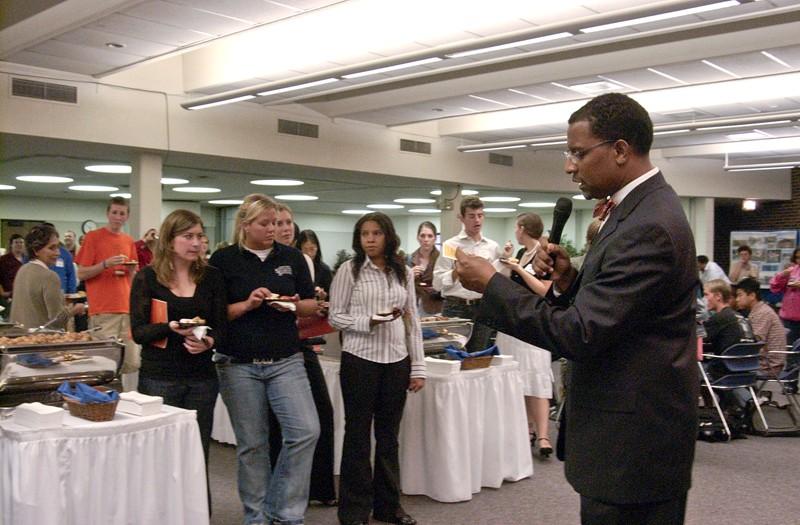Minority role models scarce at GV

GVL Archive Associate Director of Multicultural Affairs, Bobby Springer, speaks to the crowd gathered for a past Intercultural Festival.
Oct 24, 2011
In the recent myGVSU survey, 84 percent of Grand Valley State University respondents self-identified as white, but more of the 16 percent who self-identified as people of color said they have more trouble finding on-campus role models than their white counterparts.
The myGVSU survey asks students, staff and faculty a variety of questions to determine what it is like to live, work and learn at GVSU. During the first week of October, Sue Rankin, senior research associate at the Center for Higher Education, visited GVSU to deliver the survey’s results. The overall reported comfort and satisfaction rates at GVSU were lowest among people of color, with what Rankin called “significant” differences between whites and minorities.
The survey also reported that some people of color “felt singled out” based on their race as resident authorities on a particular subject.
“Most students felt very valued by faculty at GVSU … and they felt that they do have role models, except for students of color,” Rankin said. “They felt they didn’t have enough role models.”
To gain a better understanding of the issue, Bobby Springer, associate director of the Office of Multicultural Affairs, encouraged white students to imagine what it would be like if they were to “flip the script.”
“Imagine you being at an all-black school and you’re the only white student there and everybody else was African American,” he said. “If you went to class to class to class and then even your instructor was African American … that plays a big role all by itself. I’m not saying that whites can’t be role models, because they can, because we have a number of majority faculty and staff that reach out to students of color to make them feel welcome here at the university. But at the end of the day, it’s a plus for everybody when you can look across and see a reflection of yourself.”
Springer recalled his own moment of empowerment when, as a graduate student, he entered his first class and discovered the professor was also a black male.
“It gave me so much energy, zest, whatever you want to call that, that made me feel like I belong,” he said. “There’s somebody else who has accomplished this who looks like me. That gave me hope. Just seeing yourself, it does a lot for one’s soul.”
While he acknowledged the experience of being a person of color at a mostly white institution can “get lonely” for both faculty and students, Springer said the OMA plans many events to help make people of color feel welcome at GVSU, including a mixer at the start of the school year attended by students, faculty and staff.
The OMA also brings guest speakers, documentary screenings and other events to the campus to coincide with various cultural celebrations, including Cesar Chavez Week, Black History Month, Native American Heritage Month and Hispanic Heritage Month. Springer said these events are meant to act as a “double whammy” for both students of color and majority students.
A larger proportion of people of color also reported both witnessing and personally experiencing exclusionary, offensive, intimidating or harassing behavior. Thirty-nine percent of respondents of color said the harassment was based on their race, while three percent of white respondents voiced the same sentiment. People of color were also more likely to feel left out when working in groups.
For all student respondents, regardless of race, the most common place perceived harassment or exclusion took place was in the classroom and the most commonly alleged harasser was a faculty or staff member.
Dean of Students Bart Merkle said it is not uncommon for students of different races, backgrounds, cultures and sexual orientations to feel isolated or singled out.
“The fact of the matter is, there are some insensitive people out there,” he said. “Sometimes those people are faculty. Sometimes those people are students … As a university, it’s important for us to continue to reach out to people of different backgrounds and try to make Grand Valley the best, most welcoming place it can possibly be.”
Merkle said when investigating a student’s or faculty member’s initial complaint, some perceived harassment has been deliberately hurtful, but other incidents have been the result of simple misunderstandings or miscommunications. Merkle, who also teaches classes, stressed the importance of maintaining a classroom and campus environment where faculty and students alike feel comfortable, welcomed and valued.
“If we don’t ask the difficult questions that potentially might make some people uncomfortable, then we’re not doing our jobs [as educators],” he said. “But it’s important to take a step back and explain, ‘When I said this, this is what I meant or this is what my intentions were.’”
Both Merkle and Springer emphasized the value of joining a student organization or club in order for students of all races and cultures to feel more included and connected with the GVSU community. Merkle added that if a student feels their interests or identities are not represented by a current student organization, they are always welcome to start a student group of their own.
“There are over 300 student groups on campus and all of those started from someone saying, ‘Hey, let’s focus on this,’” he said. “If you are interested in something, chances are someone else out there is too.”





















